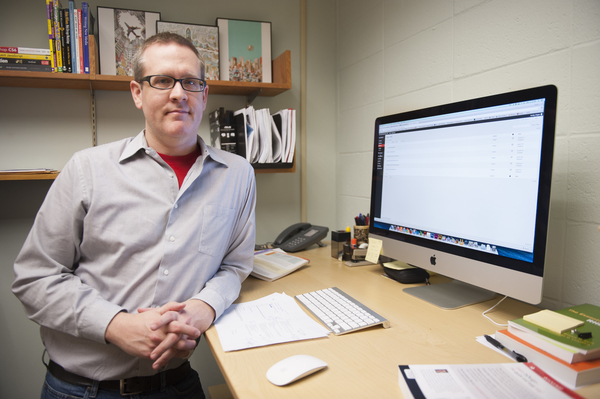
Scott Rogers, PhD
Department of English
WordPress for Blogs and Portfolios

Scott Rogers is an assistant professor in the English Department and primarily teaches courses related to writing, research, and professional communication. Because Composition Studies is so closely tied to the classroom, he spends a lot of time thinking about pedagogy, especially the unique challenges presented by college writing instruction. “Writing plays such an important role in academic and professional life. Writing is something that we all do. It’s also something that we can all do better. Adding one more wrinkle is the reality that digital media has altered many of our traditional expectations about written communication. Writing—as we have thought of it for hundreds of years—is vastly changed.” Part of Scott’s interest as a writing teacher, then, is figuring out how to prepare students for the future of communication at the same time they must adhere to traditional expectations about writing that persist in academic and professional contexts.
What is one instructional technique or project that is particularly effective, innovative, or engaging?
“I have been experimenting with technology in my classes (and in my own scholarship) for years. I’ve used presentational tools (Prezi, Slid.es), map-making applications (ThingLink, Google Maps), and digital video and audio software (iMovie, Audacity). But the one technology I can’t live without, the one that I always come back to is WordPress. This name should be familiar to the PLU community, as we’ve just transitioned to the WordPress platform. This example demonstrates the flexibility that WordPress offers. It can serve as a large-scale site management tool or it can facilitate small-scale course projects.
My favorite thing about WordPress is that it creates a context for other work. Whether we are making electronic portfolios, personal websites, course publications, new media texts (i.e. podcasts, videos, digital maps), WordPress provides a space in which we can share our ideas and collaborate virtually or in the physical classroom. It is also 100% free.”
What related tool or strategy do you use that other PLU faculty might like to try in their courses?
“I can imagine faculty using WordPress in two primary ways: as an extension of their course (e.g. a blog or publication) or as a tool for creating student e-portfolios.
First, WordPress allows faculty to create a convenient, flexible, and public space where their students can engage with course material outside of class. I’ve done this a couple different ways. One is a course blog that students use to respond to assigned reading and/or to peer comments (prior to attending class). Effectively, this gives us an opportunity to start our conversation before we’ve stepped foot in the classroom. Depending on what the discussion is meant to accomplish, the WordPress course blog can be a place to identify core claims, to collect key terms and quotations, or to reflect on how students respond to a given text. Another option is a course publication where student work can be published (for an example, take a look at an ongoing Parkland-focused project I’ve started with my FYEP students: The Parkland Atlas…hyperlink: www.parklandatlas.scottlrogers.net). Simply put, most students are already creating content for the web and will undoubtedly continue to do so whatever career they choose for themselves. WordPress offers instructors an easy way to engage with student learning in a format that promotes consideration of public discourse and the risks/rewards of writing for real audiences.
A second use for WordPress is the student portfolio. While there is an abundance of proprietary software out there for creating electronic portfolios for student work, WordPress is a free and very easy alternative. Additionally, because WordPress is free and accessible from any computer, students have a lot of flexibility in how and where they do their work. Effectively, creating an e-portfolio in WordPress is a simple matter of creating a site, adding framing materials (images, a biographical statement, assignment prompts), and posting papers, reports, reflections, and so on. There’s no limit to what it can conveniently host: print essays, links, embedded videos, or audio clips. Whatever your students are doing, there’s a way to post it to WordPress.”
What are the benefits, for you and your students, of utilizing this tool or strategy?
“When I talk about WordPress and how I use it, colleagues often express anxiety about making student work public. Due to concerns about privacy, this can be a valid concern. However, the public nature of the tool is also its greatest benefit. Publishing student work in a public forum like WordPress creates a rhetorical situation that encourages students to think carefully about purpose, audience, and ethos. Who will care about my ideas? What terms, concepts, or methods will they expect to see? What standards govern written or electronic communication in the field or profession I am trying to engage through my writing?
Making student work public is also one way that we can demonstrate that we value what students have to say. By posting their work to a WordPress site, they are participating in a public discourse on subjects that interest and challenge them. Additionally, they are doing so collaboratively (in the case of a course blog or website) as they have a space to read, comment, and reflect on their own time and in their own space.
Finally, course content can be made dynamic by hyperlinking to other sites and materials, and by embedding media or web applications. WordPress can simply be a place to post written text or it can be a backdrop for a complete multimodal engagement with the course material.
For those concerned about privacy, WordPress makes it easy to maintain anonymity via self-selected user names. Additionally, WordPress sites may be locked to outside readers (or to select readers who can request access from the site administrator). Finally, if you’re worried about what students might say, administrative duties can be switched on or off, meaning your student posts or comments must be approved prior to publication.”
What advice would you have for someone interested in trying this tool or strategy?
“The first piece of advice I’d offer is note that there are two kinds of WordPress: wordpress.com and wordpress.org. The first (.com) is the ubiquitous blogging and website creation tool. This version of WordPress is free and hosted by WordPress themselves. You can have a course up and running in minutes. This is the version I would use for student portfolios or for class blogs. Just keep in mind that, because it is hosted by WordPress, there are limitations on what it can do. The second version of WordPress (.org) is the software tool itself, which can be downloaded for free and housed on most any web-hosting site (or home server). Web-hosting sites are not free, though they are not expensive. This version of WordPress (.org) is powerful enough to create the entire PLU website. It is really only limited by the user’s coding or design skills. If you’ve got HTML or CSS chops and a little chunk of hosted server space somewhere in the world, give this version a try.”



